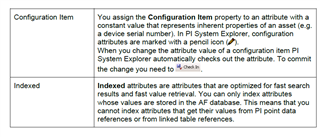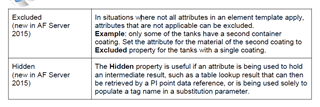Hi,
Could you please explain clearly the difference between configuration item, indexed, excluded and hidden?
I am reading the documentation but I am little but lost.
Thank you !


Hi,
Could you please explain clearly the difference between configuration item, indexed, excluded and hidden?
I am reading the documentation but I am little but lost.
Thank you !


Indexed versus Configuration Item
Both are for static AFAttributes, that is with a data reference of None. The values for the static attributes are stored in the AFDatabase meaning thats is it stored in the SQL Server's PIFD database.
Indexed means AF will create an index for fast searches. Not much to add there.
Configuration Item is denoting an AFAttribute so important that it is critical to the design of the AFElement. If you ever change it, when it should remain constant, then the state of the AFElement is saved in what is called Element Versioning. The original element probably has a Date of 1/1/1970. If you change the value of the Configuration Item, a new element version is created for that element on the date of check-in.
Let's consider an example that is not process related at all. It's more of inventory, which is a bad fit for PI and AF but may help in this example.
Imagine a car lot of cars from different manufacturers. Each car would be an AFElement and technical details about the car would be AFAttributes such as Color, Number of Doors, Cylinders, Style (SUV, Sedan, Coupe) along with general details like Manufacturer, Model, Year, etc.
General details like Manufacturer, Model, or Year are good candidates to be Indexed. Doesn't mean they should be, but rather they could be, so if you want to search on all BMW's it could be fast.
One could say that all those properties are indeed static and would never change EXCEPT there is an exception: the Color. On rare occasions, someone could paint the car a different color. So the Color is a candidate for a Configuration Item. If it ever changes, then a new element version is created.
In the HELP for Configuration Item, they mention serial numbers as likely candidates. This is true. Imagine a large piece of equipment including a certain Controller with a given serial number. Over time, components wear out and need to be replaced. If you replace that Controller with a new one, and get a new serial number, then you would want element versioning to know which is being referenced when you do a historical look back.
Indexed versus Configuration Item
Both are for static AFAttributes, that is with a data reference of None. The values for the static attributes are stored in the AFDatabase meaning thats is it stored in the SQL Server's PIFD database.
Indexed means AF will create an index for fast searches. Not much to add there.
Configuration Item is denoting an AFAttribute so important that it is critical to the design of the AFElement. If you ever change it, when it should remain constant, then the state of the AFElement is saved in what is called Element Versioning. The original element probably has a Date of 1/1/1970. If you change the value of the Configuration Item, a new element version is created for that element on the date of check-in.
Let's consider an example that is not process related at all. It's more of inventory, which is a bad fit for PI and AF but may help in this example.
Imagine a car lot of cars from different manufacturers. Each car would be an AFElement and technical details about the car would be AFAttributes such as Color, Number of Doors, Cylinders, Style (SUV, Sedan, Coupe) along with general details like Manufacturer, Model, Year, etc.
General details like Manufacturer, Model, or Year are good candidates to be Indexed. Doesn't mean they should be, but rather they could be, so if you want to search on all BMW's it could be fast.
One could say that all those properties are indeed static and would never change EXCEPT there is an exception: the Color. On rare occasions, someone could paint the car a different color. So the Color is a candidate for a Configuration Item. If it ever changes, then a new element version is created.
In the HELP for Configuration Item, they mention serial numbers as likely candidates. This is true. Imagine a large piece of equipment including a certain Controller with a given serial number. Over time, components wear out and need to be replaced. If you replace that Controller with a new one, and get a new serial number, then you would want element versioning to know which is being referenced when you do a historical look back.